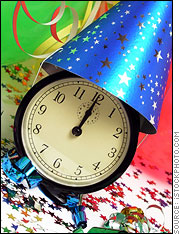The most commonly sung song for English-speakers on New Year's eve, "Auld Lang Syne" is an old Scottish song that was first published by the poet
Robert Burns in the 1796 edition of the book, Scots Musical Museum. Burns transcribed it (and made some refinements to the lyrics) after he heard it sung by an old man from the Ayrshire area of Scotland, Burns's homeland.
It is often remarked that "Auld Lang Syne" is one of the most popular songs that nobody knows the lyrics to.
"Auld Lang Syne" literally translates as "old long since" and means "times gone by." The song asks whether old friends and times will be forgotten and promises to remember people of the past with fondness, "For auld lang syne, we'll tak a cup o' kindness yet."
The lesser known verses continue this theme, lamenting how friends who once used to "run about the braes,/ And pou'd the gowans fine" (run about the hills and pulled up the daisies) and "paidl'd in the burn/Frae morning sun till dine" (paddled in the stream from morning to dusk) have become divided by time and distance—"seas between us braid hae roar'd" (broad seas have roared between us). Yet there is always time for old friends to get together—if not in person then in memory—and "tak a right guid-willie waught" (a good-will drink).
But it was bandleader
Guy Lombardo, and not Robert Burns, who popularized the song and turned it into a New Year's tradition. Lombardo first heard "Auld Lang Syne" in his hometown of London, Ontario, where it was sung by Scottish immigrants. When he and his brothers formed the famous dance band, Guy Lombardo and His Royal Canadians, the song became one of their standards. Lombardo played the song at midnight at a New Year's eve party at the Roosevelt Hotel in New York City in 1929, and a tradition was born. After that, Lombardo's version of the song was played every New Year's eve from the 1930s until 1976 at the Waldorf Astoria. In the first years it was broadcast on radio, and then on television. The song became such a New Year's tradition that "Life magazine wrote that if Lombardo failed to play 'Auld Lang Syne,' the American public would not believe that the new year had really arrived."
Hogmanay (Scotland)
The birthplace of "Auld Lang Syne" is also the home of Hogmanay (hog-mah-NAY), the rousing Scottish New Year's celebration (the origins of the name are obscure). One of the traditions is "first-footing." Shortly after midnight on New Year's eve, neighbors pay visits to each other and impart New Year's wishes. Traditionally, First foots used to bring along a gift of coal for the fire, or shortbread. It is considered especially lucky if a tall, dark, and handsome man is the first to enter your house after the new year is rung in. The Edinburgh Hogmanay celebration is the largest in the country, and consists of an all-night street party (visit their Hagmanay website
here).
Oshogatsu (Japan)The new year is the most important holiday in Japan, and is a symbol of renewal. In December, various Bonenkai or "forget-the-year parties" are held to bid farewell to the problems and concerns of the past year and prepare for a new beginning. Misunderstandings and grudges are forgiven and houses are scrubbed. At midnight on Dec. 31, Buddhist temples strike their gongs 108 times, in a effort to expel 108 types of human weakness. New Year's day itself is a day of joy and no work is to be done. Children receive otoshidamas, small gifts with money inside. Sending New Year's cards is a popular tradition—if postmarked by a certain date, the Japanese post office guarantees delivery of all New Year's cards on Jan. 1.
SpainThe Spanish ritual on New Year's eve is to eat twelve grapes at midnight. The tradition is meant to secure twelve happy months in the coming year.
The NetherlandsThe Dutch burn bonfires of Christmas trees on the street and launch fireworks. The fires are meant to purge the old and welcome the new.
Greece
In Greece, New Year's day is also the Festival of
St. Basil, one of the founders of the
Greek Orthodox Church. One of the traditional foods served is Vassilopitta, or St Basil's cake. A silver or gold coin is baked inside the cake. Whoever finds the coin in their piece of cake will be especially lucky during the coming year.
United States
Probably the most famous tradition in the United States is the dropping of the New Year ball in Times Square, New York City, at 11:59 P.M. Thousands gather to watch the ball make its one-minute descent, arriving exactly at midnight. The tradition first began in 1907. The original ball was made of iron and wood; the current ball is made of Waterford Crystal, weighs 1,070 pounds, and is six feet in diameter.
A traditional southern New Year's dish is Hoppin' John—black eyed peas and ham hocks. An old saying goes, "Eat peas on New Year's day to have plenty of everything the rest of the year."
Another American tradition is the
Rose Bowl in Pasadena, California. The Tournament of Roses parade that precedes the football game on New Year's day is made up of elaborate and inventive floats. The first parade was held in 1886.
Widely Observed New Year Symbols and Traditions
Resolutions: It is believed that the Babylonians were the first to make New Year's resolutions, and people all over the world have been breaking them ever since. The early Christians believed the first day of the new year should be spent reflecting on past mistakes and resolving to improve oneself in the new year.
Fireworks: Noisemaking and fireworks on New Year's eve is believed to have originated in ancient times, when noise and fire were thought to dispel evil spirits and bring good luck. The Chinese are credited with inventing
fireworks and use them to spectacular effect in their
New Year's celebrations.





